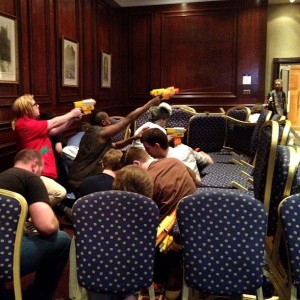Taylor Clark has a storming piece up on Kotaku today. He’s right: most popular video games are dumb. And that’s fine, so long as we don’t assume that’s the only thing games can do.
To accept childish dreck without protest-or worse, to defend the dreck’s obvious dreckiness just because the other parts of a game are cool-is to allow the form to languish forever.
Yes. Preach it. Preach it also to readers who love Dan Brown’s fiction in spite of the writing, and everyone who overlooks the hour-long goodbye scenes at the end of the Lord of the Rings films.
Most popular things are dumb, not just video games
Video games are not unique in being collaborative creations in which many elements are brought together to form a whole; nor are they alone in being often poorly integrated, with areas of brilliance marred by areas of dreck (or indeed whole areas of dreck occasionally elevated by moments of brilliance). All media have these problems.
But video gaming is such a small field at present. Our examples of brilliance and of dreck come from a depressingly limited pool of options, especially when we examine big-budget titles. Truly stand-out works in any field are rare. Most media plays to the majority. In video gaming, it is the mindless that has proven to sell well – so mindless most games remain.
Sturgeon’s Law (90% of everything is crap) applies not just to things being bad, but also to things being dumb, crude, silly. It’s not just video games; it’s also everything else. There shouldn’t be any shame for gamers in saying: yes, a lot of games are dumb. A lot of everything is dumb. A lot of dumb things are fun.
But Clark’s right that by saying video games can only be dumb, we’re doing the medium a great disservice. In the 18th century there was a widely held perception that novels could only be dumb, until classics began to emerge and a canon formed. Video gaming has been around for a much shorter time and has much farther to go before it reaches maturity – technology is still not stable, barriers to entry are still falling rapidly, the business model is still all over the place, and all those things impact the kinds of games that are produced and the processes by which they’re made. But video games can, and should, aspire to greatness, both mechanically and narratively – and ideally, both at once.
Narrative and gameplay should be the same thing
Matthew Burns, who’s worked on several big-budget games, says he doubts that such a thing is possible given the current climate. There’s a rather circular argument here. The kicker quote:
it is extremely difficult— maybe impossible— to come up with a story and characters that, when placed within the context of most current video games, don’t feel inherently silly
Most current video games are inherently silly, therefore it’s impossible to put anything on top of the silliness to produce something that’s less silly. Well – yes. There’s an assumption here about the place of writing, story and characterisation in games – that it’s not an inherent part of the context of games, but rather something added on top. But if you start from the premise that your game is about hyperviolent destruction of mythical monsters, you’ve made a lot of decisions about the story and the characterisation already. Even the best writers won’t be capable of making a game deep, believable, complex or realistic if the gameplay is fighting against that narrative at every turn. See also: GTA4.
Gameplay and narrative shouldn’t simply inform each other. They should be inextricable from each other. Games that aspire to being well written can’t just plaster story on top of mechanic like wallpaper. It has to be mixed into the mortar, built into the foundations. It doesn’t matter whether you’re gunning for embedded or emergent story, froth or experiential narrative or whatever – you can’t slap it on top of gameplay like an afterthought, because gameplay mediates the entire experience.
If you’re playing a different story than the one you’re being told, then the game can’t attain that coveted, if ill-defined, goal of comprehensive intelligence. It’ll always be fractured; no matter how carefully the cracks are hidden, it won’t ring true.
